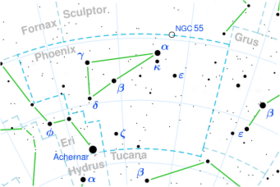Astronomy:Mu Phoenicis
| Observation data Equinox J2000.0]] (ICRS) | |
|---|---|
| Constellation | Phoenix |
| Right ascension | 00h 41m 19.55229s[1] |
| Declination | −46° 05′ 06.0184″[1] |
| Apparent magnitude (V) | 4.59[2] |
| Characteristics | |
| Spectral type | G8III[3] |
| U−B color index | +0.72[2] |
| B−V color index | +0.97[2] |
| Astrometry | |
| Radial velocity (Rv) | +17.41±0.16[4] km/s |
| Proper motion (μ) | RA: −28.20[1] mas/yr Dec.: +1.80[1] mas/yr |
| Parallax (π) | 13.27 ± 0.23[1] mas |
| Distance | 246 ± 4 ly (75 ± 1 pc) |
| Absolute magnitude (MV) | 0.21[5] |
| Details | |
| Mass | 2.50[6] M☉ |
| Radius | 13.15+2.59 −2.28[4] R☉ |
| Luminosity | 96.6±2.4[4] L☉ |
| Temperature | 4,900[7] K |
| Rotational velocity (v sin i) | 1.4[8] km/s |
| Age | 1.4[6] Gyr |
| Other designations | |
| Database references | |
| SIMBAD | data |
μ Phoenicis, Latinized as Mu Phoenicis, is a suspected astrometric binary[10] star system in the southern constellation of Phoenix. It is visible to the naked eye as a faint, yellow-hued star with an apparent visual magnitude of 4.59.[2] This system is located approximately 246 light years distant from the Sun based on parallax,[1] and is drifting further away with a radial velocity of +17.4 km/s.[4]
The visible component is an aging G-type giant star with a stellar classification of G8III.[3] Having exhausted the supply of hydrogen at its core, this star cooled and expanded off the main sequence. At present it has 13[4] times the girth of the Sun. It is 1.4[6] billion years old with 2.5[6] times the mass of the Sun. It is radiating 97[4] times the luminosity of the Sun from its swollen photosphere at an effective temperature of 4,900 K.[7]
References
- ↑ 1.0 1.1 1.2 1.3 1.4 1.5 Van Leeuwen, F. (2007). "Validation of the new Hipparcos reduction". Astronomy and Astrophysics 474 (2): 653–664. doi:10.1051/0004-6361:20078357. Bibcode: 2007A&A...474..653V. Vizier catalog entry
- ↑ 2.0 2.1 2.2 2.3 Ducati, J. R. (2002). "VizieR Online Data Catalog: Catalogue of Stellar Photometry in Johnson's 11-color system". CDS/ADC Collection of Electronic Catalogues 2237. Bibcode: 2002yCat.2237....0D.
- ↑ 3.0 3.1 Houk, Nancy (1978). Michigan catalogue of two-dimensional spectral types for the HD stars. 2. Ann Arbor: Dept. of Astronomy, University of Michigan. Bibcode: 1978mcts.book.....H.
- ↑ 4.0 4.1 4.2 4.3 4.4 4.5 Brown, A. G. A. (August 2018). "Gaia Data Release 2: Summary of the contents and survey properties". Astronomy & Astrophysics 616: A1. doi:10.1051/0004-6361/201833051. Bibcode: 2018A&A...616A...1G. Gaia DR2 record for this source at VizieR.
- ↑ Anderson, E.; Francis, Ch. (2012). "XHIP: An extended hipparcos compilation". Astronomy Letters 38 (5): 331. doi:10.1134/S1063773712050015. Bibcode: 2012AstL...38..331A. Vizier catalog entry
- ↑ 6.0 6.1 6.2 6.3 Luck, R. Earle (2015). "Abundances in the Local Region. I. G and K Giants". The Astronomical Journal 150 (3): 88. doi:10.1088/0004-6256/150/3/88. Bibcode: 2015AJ....150...88L.
- ↑ 7.0 7.1 Gontcharov, G. A. (2009). "Red giant clump in the Tycho-2 catalogue". Astronomy Letters 34 (11): 785–796. doi:10.1134/S1063773708110078. Bibcode: 2008AstL...34..785G. Vizier catalog entry
- ↑ De Medeiros, J. R.; Alves, S.; Udry, S.; Andersen, J.; Nordström, B.; Mayor, M. (2014). "A catalog of rotational and radial velocities for evolved stars". Astronomy & Astrophysics 561: A126. doi:10.1051/0004-6361/201220762. Bibcode: 2014A&A...561A.126D. Vizier catalog entry
- ↑ "mu Phe". SIMBAD. Centre de données astronomiques de Strasbourg. http://simbad.u-strasbg.fr/simbad/sim-basic?Ident=mu+Phe.
- ↑ Eggleton, P. P.; Tokovinin, A. A. (September 2008). "A catalogue of multiplicity among bright stellar systems". Monthly Notices of the Royal Astronomical Society 389 (2): 869–879. doi:10.1111/j.1365-2966.2008.13596.x. Bibcode: 2008MNRAS.389..869E.
 |


